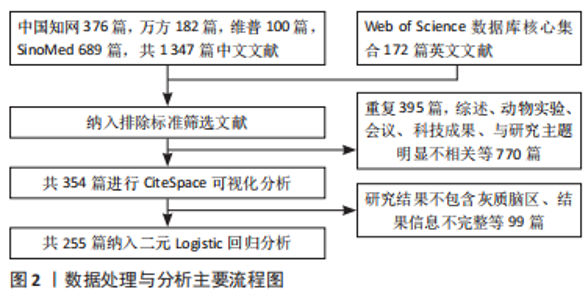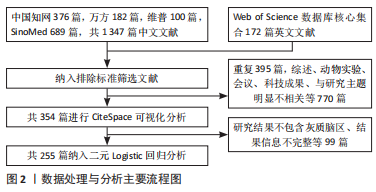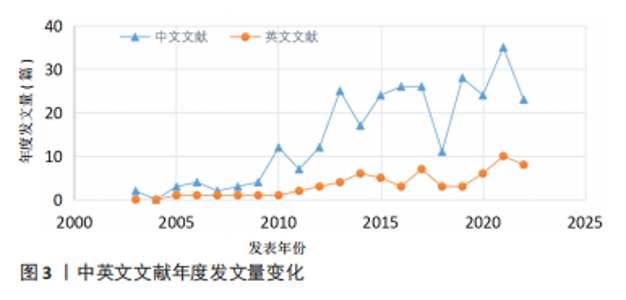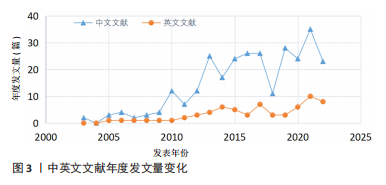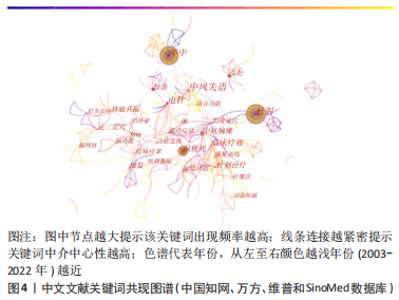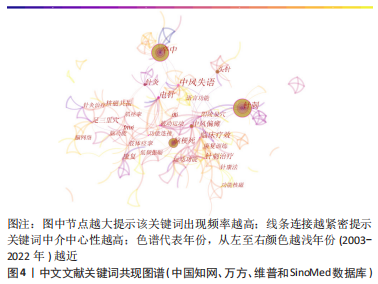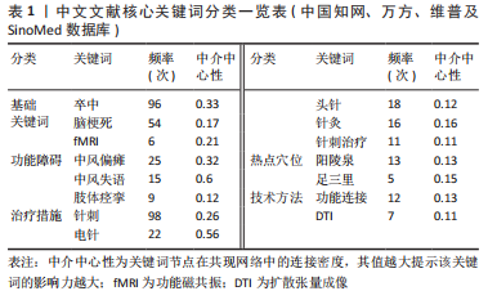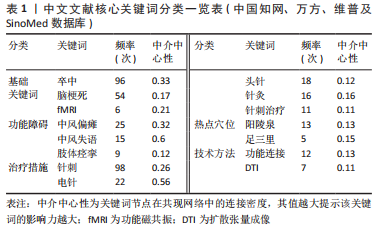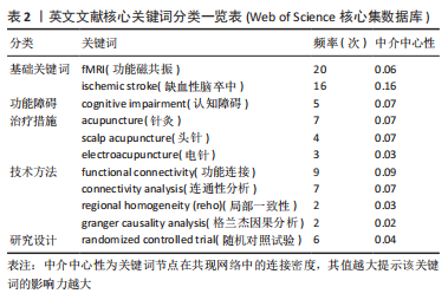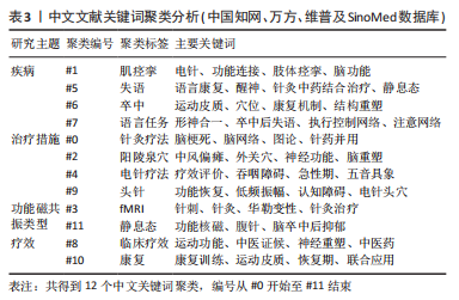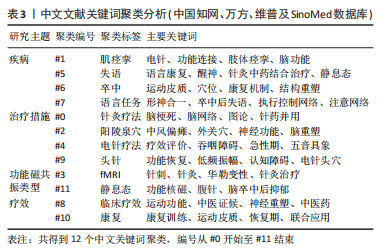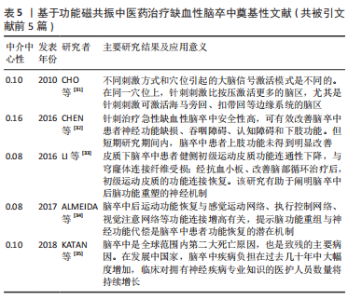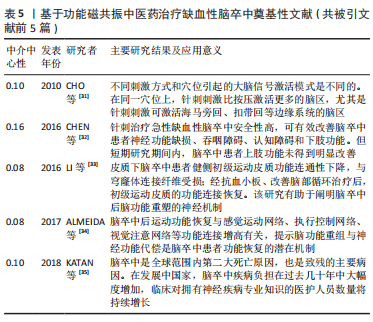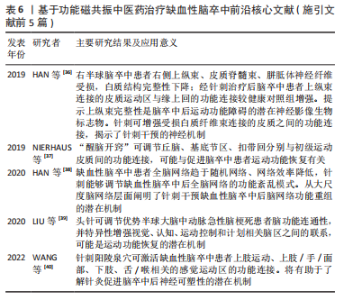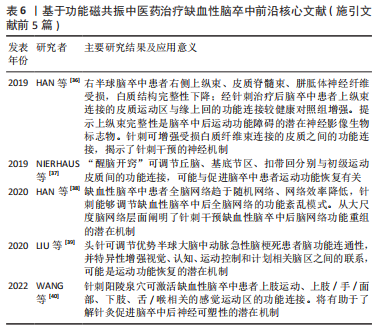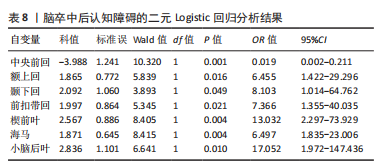Chinese Journal of Tissue Engineering Research ›› 2024, Vol. 28 ›› Issue (11): 1789-1796.doi: 10.12307/2024.227
Previous Articles Next Articles
Research hotspots and frontiers of functional magnetic resonance imaging in treatment of ischemic stroke by traditional Chinese medicine
Xu Kangli1, An Lanhua2, Zhang Jinsheng1, 2, Du Xiaoyan1, Yin Lele1, Zhang Xixian3
- 1Henan University of Chinese Medicine, Zhengzhou 450003, Henan Province, China; 2The Third Affiliated Hospital of Henan University of Chinese Medicine, Zhengzhou 450003, Henan Province, China; 3Medical School of Henan University of Science and Technology, Luoyang 471000, Henan Province, China
-
Received:2023-02-04Accepted:2023-03-02Online:2024-04-18Published:2023-07-27 -
Contact:Zhang Jinsheng, MD, Chief physician, Professor, Doctoral supervisor, Henan University of Chinese Medicine, Zhengzhou 450003, Henan Province, China; The Third Affiliated Hospital of Henan University of Chinese Medicine, Zhengzhou 450003, Henan Province, China -
About author:Xu Kangli, Master candidate, Henan University of Chinese Medicine, Zhengzhou 450003, Henan Province, China -
Supported by:Central Plains Science and Technology Outstanding Innovative Talents Project, No. 2020[48] (to ZJS); the Key Research, Development and Promotion Project of Henan Province in 2021, No. 212102311134 (to ZJS)
CLC Number:
Cite this article
Xu Kangli, An Lanhua, Zhang Jinsheng, Du Xiaoyan, Yin Lele, Zhang Xixian. Research hotspots and frontiers of functional magnetic resonance imaging in treatment of ischemic stroke by traditional Chinese medicine[J]. Chinese Journal of Tissue Engineering Research, 2024, 28(11): 1789-1796.
share this article
Add to citation manager EndNote|Reference Manager|ProCite|BibTeX|RefWorks
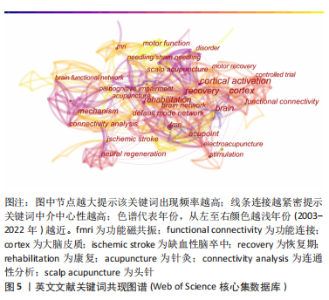
英文文献共177个关键词被纳入共现图谱,见图5。文章纳入英文文献数量较少,因此将中介中心性节点设置 > 0.01为核心关键词。对其分类分析可知,“fMRI”“ischemic stroke”为主要研究内容,与中文文献一致。“cognitive impairment(认知障碍)”是功能障碍类型的研究热点。“acupuncture(针刺)”“scalp acupuncture(头针)”“electroacupuncture(电针)”为主要治疗措施,其中“acupuncture(针刺)”频率、中介中心性均最高,为治疗方面的首要研究热点。“functional connectivity(功能连接)”是功能磁共振数据处理中的首要研究热点,与中文文献结果一致;“connectivity analysis(连通性分析)”“regional homogeneity (reho)(局部一致性)”“granger causality analysis(格兰杰因果分析)”亦是主要数据分析技术方法。此外,英文文献更注重对研究方法的设计,“randomized controlled trial(随机对照试验)”是研究设计方面的热点,见表2。"
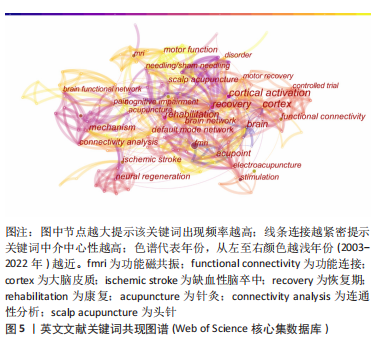
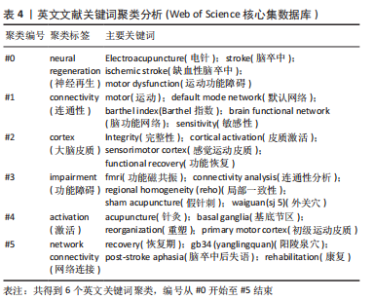
以疾病研究主题为例进行诠释,#1肌痉挛聚类的研究自2003年持续至2022年,研究热度集中在2010-2015年,该聚类中脑卒中后肌痉挛、肢体痉挛为主要研究对象,以观察针刺督脉、颈夹脊穴、百会穴对卒中后肌痉挛患者脑功能的影响,探究其中枢机制为主要研究内容[15-17];2015年后时间线上关键词节点稀疏,该聚类研究逐渐趋冷。#6卒中聚类的研究内容以探究穴位刺激对促进运动功能恢复的脑效应机制为主[18-19],该聚类研究自2003持续至2021年,研究热度集中在2010-2021年。#5、#7聚类均为脑卒中后失语,自2007年持续至2021年,研究热度均集中在2015-2021年,#5失语聚类中,“益髓醒神”针法、“通督调神”成为脑卒中后失语的热点干预措施,该阶段研究以采用静息态功能磁共振观察“益髓醒神”“通督调神”针法对脑卒中后失语患者脑网络连通性的影响为主[20-21]。#7语言任务聚类中,研究内容以基于词-图匹配语言任务,揭示卒中后失语患者语言加工机制为主[22-23]。 英文文献关键词共获取6个类别,分别代表不同的研究主题,依次用编号#0、#1、#2······#5表示,分别为#0 neural regeneration(神经再生)、#1 connectivity(连通性)、#2 cortex(大脑皮质)、#3 impairment(功能障碍)、#4 activation(激活)、#5 network connectivity(网络连接),见表4。"
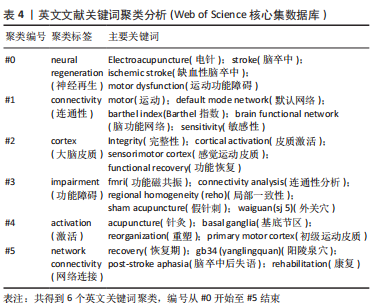
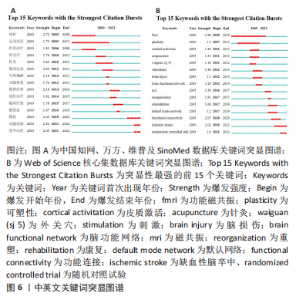
每个聚类的研究热度随时间而变化,结果显示#0 neural regeneration(神经再生)、#2 cortex(大脑皮质)、#4 activation(激活)均属于脑效应机制研究,#0 neural regeneration(神经再生)主题的研究热点自2006年持续至2022年,研究热度集中在2010-2017年,Electroacupuncture(电针)为该主题下影响力最大的干预措施,脑卒中后运动功能障碍为主要研究对象[24]。#2 cortex(大脑皮质)主题的研究自2006年持续至2022年,研究热度集中在2013-2018年,该主题的研究内容以探究与脑卒中后功能恢复相关的皮质激活、脑功能或结构的完整性等中枢神经机制为主[25-26]。#4 activation(激活)主题的研究自2008年持续至2021年,研究热度集中于2010-2021年,研究内容以对比acupuncture(针刺)和sham acupuncture(假针刺)刺激对脑功能的影响进而探究穴位特异性为主[27]。#1 connectivity(连通性)、#5 network connectivity(网络连接)聚类属于分析技术层面的研究主题。#1 connectivity(连通性)研究自2007年持续至2022年,研究热度集中在2012-2014年;#5 network connectivity(网络连接)研究自2007年持续至2019年,研究热度集中在2007-2015年。#1 connectivity(连通性)、#5 network connectivity(网络连接)主题以揭示脑卒中后失语、运动功能障碍的中枢机制为主,其中以探究default mode network(默认网络)内的功能连接的改变为主[28-29]。 2.3.3 关键词突显图谱 对关键词进行突显性检测有助于探索某一时间段内影响力较大的研究热点,通过突显词的变化可以识别该领域前沿热点[11]。中文关键词突显图谱显示,2003-2019年突显词的动态演变与共现分析、聚类分析结果基本一致。2019-2022年“图论”“功能连接”“度中心性”成为该领域中影响力较大的研究热点,且爆发力较强,为当前研究前沿热点,见图6A。英文关键词突显图谱显示,2019-2022年,“rehabilitation(康复)”“default mode network(默认网络)”“functional connectivity(功能连接)”“ischemic stroke(缺血性脑卒中)”“randomized controlled trial(随机对照试验)”在该领域中影响力大、爆发力强,为当前研究前沿热点,见图6B。"
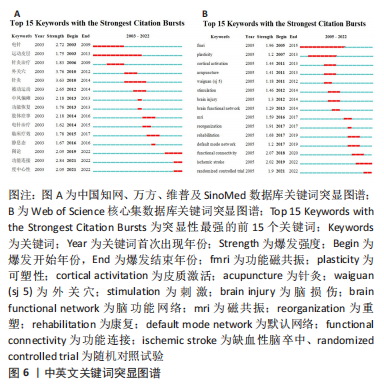
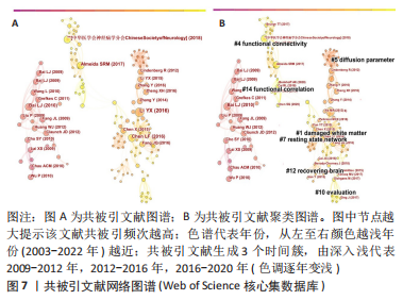
2.4 文献引文分析结果 对所研究文献进行直观可视化的引文分析,可辨别该领域研究前沿的奠基性文献和核心文献。由于CiteSpace软件功能的局限性,暂不能对中文文献进行引文分析,故此处仅限于英文文献。 2.4.1 奠基性文献 引文分析中节点中心性大、频次高等具有标志性的共被引文献被认为是奠基性文献,为领域内研究前沿和热点的理论基础[30]。使用CiteSpace软件构建共被引文献图谱,见图7A,综合判断共被引文献中介中心性与频次,提取前5篇绘制奠基性文献表可知,缺血性脑卒中的流行病学调查、针刺治疗脑卒中的安全性及有效性、不同任务下大脑激活模式、脑卒中后脑网络内或网络间功能连接异常等潜在的神经病理机制为该领域研究的理论基础[31-35],见表5。 2.4.2 前沿核心文献 前沿核心文献是覆盖共被引文献较多、影响力较大,与该领域紧密相关的研究(本质为施引文献)。对共引文献进行聚类分析,得出相应时间段下前沿研究主题,见图7B。高中介中心性的施引文献常是连接不同研究主题之间的桥梁,在研究发展中起重要作用,被认为是该领域中研究前沿的核心文献[30],提取前5篇绘制前沿核心文献表可知,探索中医药靶向脑区与神经网络,揭示中医药促进脑卒中后神经重构的脑效应机制为该领域的研究方向[36-40],见表6。"
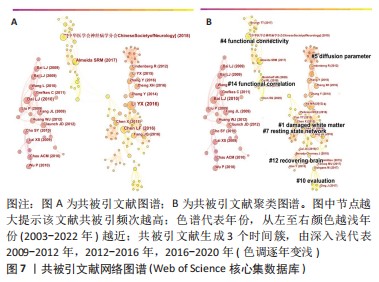
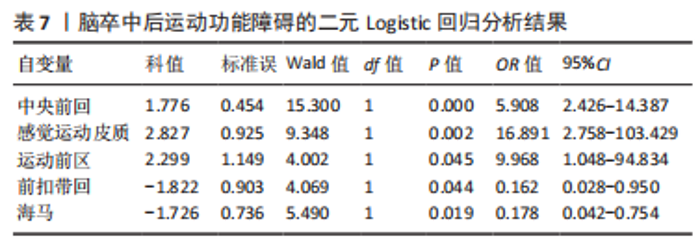
2.5 二元Logistic回归分析结果 文章共纳入255篇文献进行二元Logistic回归分析,包含脑卒中后肢体运动功能障碍(包含偏瘫在内,91篇,35.69%)、脑卒中后失语(71篇,27.84%)、脑卒中后认知障碍(45篇,17.65%)、脑卒中后情感障碍(37篇,14.51%)、脑卒中后吞咽障碍(11篇,4.31%)。将功能障碍类型作为因变量。文献中与健康对照组相比,缺血性脑卒中后患者神经功能活动异常的灰质脑区作为自变量。频数≥5的灰质脑区经χ2检验排除共线性后,共纳入43个灰质脑区构建二元Logistic回归模型。其中脑卒中后失语二元Logistic回归模型的Hosmer-Lemeshow模型检验χ2=186.393,P < 0.05,提示模型拟合度较差,不能准确反映脑卒中后失语患者神经功能异常的灰质脑区分布,故将该模型剔除。 2.5.1 脑卒中后运动功能障碍二元Logistic回归模型 将脑卒中后运动功能障碍作为因变量,43个灰质脑区作为自变量纳入二元Logistic回归,共5个灰质脑区进入方程,见表7。Hosmer-Lemeshow模型检验χ2=3.015,P > 0.05,提示回归模型拟合度良好,预测准确率为81.60%。由表7可知,中央前回、感觉运动皮质、运动前区B > 0,OR > 1,提示三者神经功能异常与脑卒中后运动功能障碍的发生呈正相关,为危险因素。前扣带回、海马B < 0,OR < 1,二者神经功能异常不作为脑卒中后运动功能障碍发生的依据。"
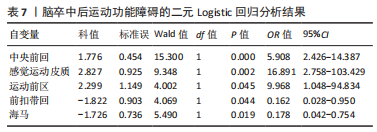
| [1] GBD 2019 STROKE COLLABORATORS. Global, regional, and national burden of stroke and its risk factors, 1990-2019: a systematic analysis for the Global Burden of Disease Study 2019. Lancet Neurol. 2021;20(10):795-820. [2] 周雨帆,徐敏杰,谭逸海,等.基于结构协变网络探索卒中后失语结构损伤特征[J].中国康复理论与实践,2022,28(10):1198-1204. [3] 林志诚,游咏梅,王君,等.脑卒中后吞咽障碍患者下丘脑功能连接和全脑各向异性的磁共振成像研究[J].中国康复理论与实践,2021,27(5):504-509. [4] 田婧,范晨雨,李浩正,等.基于功能性近红外光谱技术的脑卒中后运动功能障碍患者脑网络功能连接研究[J].中国康复医学杂志,2022,37(5):600-605. [5] CAO BQ, TAN F, ZHAN J, et al. Mechanism underlying treatment of ischemic stroke using acupuncture: transmission and regulation. Neural Regen Res. 2021; 16(5):944-954. [6] SHI P, SUN LL, LEE YS, et al. Electroacupuncture regulates the stress-injury-repair chain of events after cerebral ischemia/reperfusion injury. Neural Regen Res. 2017;12(6):925-930. [7] SU XT, WANG L, MA SM, et al. Mechanisms of acupuncture in the regulation of oxidative stress in treating ischemic stroke. Oxid Med Cell Longev. 2020;2020:7875396. [8] JIA H, HE J, ZHAO L, et al. Combination of stem cell therapy and acupuncture to treat ischemic stroke: a prospective review. Stem Cell Res Ther. 2022;13(1):87. [9] 李沁,肖端,徐亚林.脑卒中后认知障碍的静息态功能磁共振成像研究进展[J].中国康复医学杂志,2022,37(6):850-854. [10] 俞璐,王踉碕,王丽玮,等.基于功能性磁共振成像评价中医药对缺血性脑卒中脑功能网络连接影响的研究进展[J].世界科学技术-中医药现代化, 2022,24(7):2802-2808. [11] 陈悦,陈超美,刘则渊,等.CiteSpace知识图谱的方法论功能[J].科学学研究, 2015,33(2):242-253. [12] CHEN C, HU Z, LIU S, et al. Emerging trends in regenerative medicine: a scientometric analysis in CiteSpace. Expert Opin Biol Ther. 2012;12(5):593-608. [13] 崔淑兰,李萍,樊一波,等.围绝经期综合征常见证型证候特征的二元Logistic回归分析[J].中华中医药杂志,2022,37(7):4121-4124. [14] 李杰,陈超美.CiteSpace:科技文本挖掘及可视化[M].北京:首都经济贸易大学出版社, 2016:89. [15] 涂永梅.通督解痉法配合牵伸康复技术对梗塞后肌痉挛患者的脑功能变化研究[D].成都:成都中医药大学,2015. [16] 贺洋洋.通督解痉法对中风后肌痉挛患者的脑区激活及其机制的研究[D].成都:成都中医药大学,2014. [17] 劳祥婷.针刺督脉及被动运动对脑卒中后肢体痉挛的脑功能即时效应的影响[D]. 成都:成都中医药大学,2014. [18] 阳运秋,唐纯志,崔韶阳,等.靳三针结合镜像疗法对脑卒中上肢功能障碍患者脑功能效应的影响[J].中医杂志,2019,60(8):675-679. [19] 江征,卓丽萍,廖少钦,等.穴位不同刺激方式改善缺血性脑卒中患者手功能障碍的临床观察[J].康复学报,2017,27(4):7-12. [20] 张斌龙.基于双流模型网络的失语症“益髓醒神”针刺干预机制研究[D].北京:北京中医药大学,2019. [21] 李晓琳.“益髓醒神”针刺治疗卒中后失语的脑微观结构与功能网络MRI研究[D].北京:北京中医药大学,2021. [22] 李晓琳.“形神合一”理论指导下卒中后失语的语言任务fMRI研究[D]. 北京:北京中医药大学,2018. [23] 李晓琳,张斌龙,樊瑞文,等.词图语言任务在卒中后失语功能磁共振成像实验中的刺激模式及模型研究进展[J].中国康复理论与实践,2020,26(6):668-672. [24] CHEN Y, PAN Z, MENG F, et al. Magnetic resonance imaging assessment of the therapeutic effect of combined electroacupuncture and stem cells in acute peripheral nerve injury. Front Cell Neurosci. 2022;16:1065557. [25] CHUNG WY, LIU SY, GAO JC, et al. Modulatory effect of International Standard Scalp Acupuncture on brain activation in the elderly as revealed by resting-state fMRI. Neural Regen Res. 2019;14(12):2126-2131. [26] CHUNYONG L, YINGKAI L, FUDA L, et al. Longitudinal changes of motor cortex function during motor recovery after stroke. Top Stroke Rehabil. 2022. doi:10.1080/10749357.2022.2051829. [27] SCHAECHTER JD, CONNELL BD, STASON WB, et al. Correlated change in upper limb function and motor cortex activation after verum and sham acupuncture in patients with chronic stroke. J Altern Complement Med. 2007;13(5):527-532. [28] ZHANG C, XIA Y, FENG T, et al. Disrupted functional connectivity within and between resting-state networks in the subacute stage of post-stroke aphasia. Front Neurosci. 2021;15:746264. [29] LI Y, YU Z, ZHOU X, et al. Aberrant interhemispheric functional reciprocities of the default mode network and motor network in subcortical ischemic stroke patients with motor impairment: a longitudinal study. Front Neurol. 2022;13:996621. [30] 惠小珊,陆诗超,刘咏梅,等.基于多分析方法联合的中医药调控mTOR通路文献计量学及可视化分析[J].中国实验方剂学杂志,2023,29(1):155-162. [31] CHO SY, JAHNG GH, PARK SU, et al. fMRI study of effect on brain activity according to stimulation method at LI11, ST36: painful pressure and acupuncture stimulation of same acupoints. J Altern Complement Med. 2010;16(4):489-495. [32] CHEN L, FANG J, MA R, et al. Additional effects of acupuncture on early comprehensive rehabilitation in patients with mild to moderate acute ischemic stroke: a multicenter randomized controlled trial. BMC Complement Altern Med. 2016;16:226. [33] LI Y, WANG D, ZHANG H, et al. Changes of brain connectivity in the primary motor cortex after subcortical stroke: a multimodal magnetic resonance imaging study. Medicine (Baltimore). 2016;95(6):e2579. [34] ALMEIDA SR, VICENTINI J, BONILHA L, et al. Brain connectivity and functional recovery in patients with ischemic stroke. J Neuroimaging. 2017;27(1):65-70. [35] KATAN M, LUFT A. Global Burden of Stroke. Semin Neurol. 2018;38(2):208-211. [36] HAN X, BAI L, SUN C, et al. Acupuncture enhances communication between cortices with damaged white matters in poststroke motor impairment. Evid Based Complement Alternat Med. 2019;2019:4245753. [37] NIERHAUS T, CHANG Y, LIU B, et al. Somatosensory stimulation with XNKQ acupuncture modulates functional connectivity of motor areas. Front Neurosci. 2019;13:147. [38] HAN X, JIN H, LI K, et al. Acupuncture modulates disrupted whole-brain network after ischemic stroke: evidence based on graph theory analysis. Neural Plast. 2020;2020:8838498. [39] LIU H, CHEN L, ZHANG G, et al. Scalp acupuncture enhances the functional connectivity of visual and cognitive-motor function network of patients with acute ischemic stroke. Evid Based Complement Alternat Med. 2020;2020:8836794. [40] WANG Y, WANG L, WANG Y, et al. Sensorimotor responses in post-stroke hemiplegic patients modulated by acupuncture at Yanglingquan (GB34): a fMRI study using intersubject functional correlation (ISFC) analysis. Front Neurol. 2022;13:900520. [41] 刘婷,郭晓鹏,李丽娟,等.卒中后早期认知下降患者默认模式网络和执行控制网络改变的功能磁共振成像研究[J].中华老年心脑血管病杂志,2022, 24(11):1164-1168. [42] 陈天竹,邹忆怀,杜钟名,等.手足十二针对缺血性脑卒中偏瘫患者大脑初级运动区与小脑功能连接的影响[J].中医杂志,2021,62(17):1514-1521. [43] 何永强,马铁明,许允发,等.电针头穴治疗脑卒中后肩手综合征Ⅰ期的即刻效应研究和多功能磁共振成像研究[J].中华中医药学刊,2022,40(1):161-164. [44] 杨福霞,侯冬梅,高进云,等.针刺对脑梗死后运动功能与各部位皮质脊髓束的影响[J].中华中医药杂志,2021,36(11):6888-6892. [45] 朱丹,刘永康,厉励,等.基于fMRI技术观察中西医结合治疗对急性缺血性脑卒中默认网络的影响[J].南京中医药大学学报,2021,37(6):871-877. [46] 吕天丽,常静玲,杨财水,等.“形神合一”针刺综合方案治疗卒中后基底节失语验案的脑影像分析[J].环球中医药, 2018,11(6):904-908. [47] 陆梦馨,杜钟名,江澜,等.基于Granger因果关系探究中风偏瘫患者的针刺脑效应机制[J].中华中医药杂志,2022,37(5):2745-2750. [48] JIN C, QI S, TENG Y, et al. Altered degree centrality of brain networks in parkinson’s disease with freezing of gait: a resting-state functional MRI study. Front Neurol. 2021;12:743135. [49] 杜钟名,方继良,陆梦馨,等.针刺中风患者阳陵泉后度中心性及动态度中心性变异系数变化的fMRI研究[J].中国医学物理学杂志,2022,39(1):38-43. [50] 宋杰,王大明,李永祥,等.脑卒中患者运动网络和默认网络的功能连接变化[J].中华物理医学与康复杂志,2018,40(4):314-317. [51] 陈美钟,王志敏,邬裕樊,等.基于度中心度和格兰杰因果分析对基底节区早期缺血性脑卒中患者的脑网络有效连接变化研究[J].临床放射学杂志, 2022,41(3):410-414. [52] LIU L, XIAO Y, ZHANG W, et al. Functional changes of neural circuits in stroke patients with dysphagia: a meta-analysis. J Evid Based Med. 2017;10(3):189-195. [53] 易小琦,黄俊浩,陈暇女,等.针刺促进缺血性脑卒中功能恢复的静息态功能连接研究[J].中国康复医学杂志,2021,36(4):383-387. [54] 韩笑,宁艳哲,李匡时,等.基于功能磁共振成像的针刺阳陵泉对脑卒中患者执行控制网络影响研究[J].中华中医药杂志,2017,32(5):2128-2131. [55] 文巧,兰蕾,刘雅兰,等.基于功能磁共振技术的针刺机制研究现状分析[J].中华中医药杂志,2022,37(9):5463-5466. [56] 黄亚青,刘斌,杨明,等.慢性缺血性脑卒中患者全脑功能网络小世界属性改变[J].中华医学杂志,2016,96(3):185-188. [57] CHEN H, SHI M, ZHANG H, et al. Different patterns of functional connectivity alterations within the default-mode network and sensorimotor network in basal ganglia and pontine stroke. Med Sci Monit. 2019;25:9585-9593. [58] JEUN SS, KIM JS, KIM BS, et al. Acupuncture stimulation for motor cortex activities: a 3T fMRI study. Am J Chin Med. 2005;33(4):573-578. [59] KIM MS, MOON BS, AHN JY, et al. Elucidating the mechanisms of post-stroke motor recovery mediated by electroacupuncture using diffusion tensor tractography. Front Neurol. 2022;13:888165. [60] ROLLS ET, CHENG W, DU J, et al. Functional connectivity of the right inferior frontal gyrus and orbitofrontal cortex in depression. Soc Cogn Affect Neurosci. 2020;15(1):75-86. [61] ROLLS ET. The cingulate cortex and limbic systems for emotion, action, and memory. Brain Struct Funct. 2019;224(9):3001-3018. [62] 刘琪,陈宇,刘畅,等.小脑卒中患者认知域受损特点及影像学研究进展[J].中国卒中杂志,2021,16(3):298-302. [63] 邬刚,马鹏程,涂坤,等.吞咽功能相关脑功能区激活机制的血氧水平依赖功能磁共振研究[J].神经损伤与功能重建,2022,17(7):413-415. [64] BOILLAT Y, BAZIN PL, VAN DER ZWAAG W. Whole-body somatotopic maps in the cerebellum revealed with 7T fMRI. Neuroimage. 2020;211:116624. [65] LI BJ, FRISTON K, MODY M, et al. A brain network model for depression: from symptom understanding to disease intervention. CNS Neurosci Ther. 2018;24(11): 1004-1019. [66] CHENG W, ROLLS ET, QIU J, et al. Medial reward and lateral non-reward orbitofrontal cortex circuits change in opposite directions in depression. Brain. 2016;139(Pt 12):3296-3309. |
| [1] | Zhang Xiaoyun, Liu Hua, Chai Yuan, Chen Feng, Zeng Hao, Gao Zhengang, Huang Yourong. Effect of Yishen Gushu Formula on bone metabolic markers and clinical efficacyn in patients with osteoporosis of kidney deficiency and blood stasis type [J]. Chinese Journal of Tissue Engineering Research, 2024, 28(8): 1155-1160. |
| [2] | Pan Xiaolong, Fan Feiyan, Ying Chunmiao, Liu Feixiang, Zhang Yunke. Effect and mechanism of traditional Chinese medicine on inhibiting the aging of mesenchymal stem cells [J]. Chinese Journal of Tissue Engineering Research, 2024, 28(7): 1091-1098. |
| [3] | Xu Canli, He Wenxing, Wang Lei, Wu Fangting, Wang Jiahui, Duan Xuelin, Zhao Tiejian, Zhao Bin, Zheng Yang. Bibliometric analysis of researches on liver organoids [J]. Chinese Journal of Tissue Engineering Research, 2024, 28(7): 1099-1104. |
| [4] | Sun Yukang, Song Lijuan, Wen Chunli, Ding Zhibin, Tian Hao, Ma Dong, Ma Cungen, Zhai Xiaoyan. Visualization analysis of stem cell therapy for myocardial infarction based on Web of Science in recent ten years [J]. Chinese Journal of Tissue Engineering Research, 2024, 28(7): 1143-1148. |
| [5] | Wei Yuanxun, Chen Feng, Lin Zonghan, Zhang Chi, Pan Chengzhen, Wei Zongbo. The mechanism of Notch signaling pathway in osteoporosis and its prevention and treatment with traditional Chinese medicine [J]. Chinese Journal of Tissue Engineering Research, 2024, 28(4): 587-593. |
| [6] | Liu Luxing, Di Mingyuan, Yang Qiang. Signaling pathways in the mechanism underlying active ingredients of Chinese medicine in the treatment of osteoarthritis [J]. Chinese Journal of Tissue Engineering Research, 2024, 28(4): 609-614. |
| [7] | Gong Xuan, Wang Qian, Lin Junbin. Visual analysis of extracorporeal shock wave therapy for pain [J]. Chinese Journal of Tissue Engineering Research, 2024, 28(11): 1749-1755. |
| [8] | Mo Jian, Ye Sentao, Zhang Xiaoyun. Progress in the treatment of knee osteoarthritis with monomer and compound Chinese medicine [J]. Chinese Journal of Tissue Engineering Research, 2024, 28(11): 1756-1761. |
| [9] | Ying Chunmiao, Pan Xiaolong, Liu Feixiang, Chen Na, Fan Feiyan, Zhang Yunke. Effect of traditional Chinese medicine and compounds for supplementing qi and activating blood circulation and inducing resuscitation on regulating stem cells to promote nerve repair of acute ischemic stroke [J]. Chinese Journal of Tissue Engineering Research, 2024, 28(1): 121-130. |
| [10] | Yang Ting, Ding Zhibin, Jiang Nan, Han Hongxia, Hou Miaomiao, Ma Cungen, Song Lijuan, Li Xinyi. Astrocytes regulate glial scar formation in cerebral ischemic stroke [J]. Chinese Journal of Tissue Engineering Research, 2024, 28(1): 131-138. |
| [11] | Ma Suilu, He Zhijun, Liu Tao, Li Yan, He Yuanxu, He Bo, Wang Weiwei, Wei Xiaotao. Traditional Chinese medicine monomer in the prevention and treatment of flap necrosis by regulating “autophagy” [J]. Chinese Journal of Tissue Engineering Research, 2024, 28(1): 153-158. |
| [12] | Nie Chenchen, Su Kaiqi, Gao Jing, Fan Yongfu, Ruan Xiaodi, Yuan Jie, Duan Zhaoyuan, Feng Xiaodong. The regulatory role of circular RNAs in cerebral ischemia-reperfusion injury [J]. Chinese Journal of Tissue Engineering Research, 2023, 27(8): 1286-1291. |
| [13] | Yin Shuoxin, Zhang Tao, Wang Shuping, Lu Xin, Huang Xuping, Yin Mengying, Yang Yuwei, Yuan Bingmao, Mao Zhihua, Chen Yuanneng. Bibliometric and visualized analysis of researches on gastric cancer stem cells [J]. Chinese Journal of Tissue Engineering Research, 2023, 27(6): 941-947. |
| [14] | Ma Suilu, He Zhijun, Liu Tao, Li Jinpeng, Li Yan, He Bo, Wei Xiaotao, Wang Weiwei. Traditional Chinese medicine regulates nuclear factor-kappa B signaling pathway against ischemia-reperfusion injury of skin flaps [J]. Chinese Journal of Tissue Engineering Research, 2023, 27(35): 5721-5726. |
| [15] | Wang Shaona, Liu Feixiang, Ying Chunmiao, Gao Chen, Zhang Yunke. Action mechanism of traditional Chinese medicine combined with bone marrow mesenchymal stem cells in regulating blood-brain barrier after cerebral ischemia reperfusion injury [J]. Chinese Journal of Tissue Engineering Research, 2023, 27(33): 5377-5384. |
| Viewed | ||||||
|
Full text |
|
|||||
|
Abstract |
|
|||||
